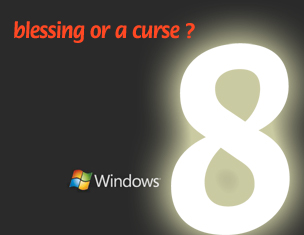
There’s no doubt that Windows 8 is going to be a well-developed, properly thought-out, and highly criticized, loved and loathed operating system. Current Windows 8 news (L) is showing a range of issues from the basic to the exotic. For web designers, however, the problems are likely to be potentially fundamental.
The problems start with some very interesting ideas- Windows 8 is a very ambitious operating system, the first even to be credibly rumored to have 128 bit architecture. As anyone who’s ever used 64 bit architecture knows, that extra grunt comes with a few caveats in terms of real world software.
These problems really happen at the other end of web design. Using the latest systems is always fun for designers, but consider for a moment the problems of designing websites for use by 32, 64 and 128 bit systems. If you’ve ever used an old computer with 16 bit architecture online, you’ll have not-particularly fond memories of the computer’s performance. 32 bit architecture is now becoming a bit archaic, but it’s still standard.
Dumb it down, or take it higher?
So there you are, trying to design a website with Windows 8, and you’re basically stuck with a 32 bit market. Business clients also tend to drag the chain on upgrades, and it’s not impossible to design a site that won’t run too well on the client’s own software. It’s all well and good to talk about the virtues of 128 bit grunt and power, but the fact is that the mass market is dumbed down to 32 bit capabilities.
Meaning, templates are the likely scenario. It’s like using a Ferrari as a tractor to use high powered architecture on designing these things, but they’ll cover the weak spots effectively. They’re static, common denominators. The other big issue with Windows 8 is the visual media. Spin screens, etc. are the current market hype visual products, but these too are designed for good systems, not clunkers.
These performance issues are unavoidable, but there’s another, emerging issue- Hardware. You’ll be aware that 128 bit architecture, being what it is, is also a more or less built-in default demand for better hardware, particularly for peripherals. As it is, Windows 7 doesn’t support some standard webcams, etc. Windows 8 will create a need for hardware. If you remember the howls about needing new hardware for Vista, consider the design issues in creating media that won’t run on mainstream systems, or won’t run well.
The choice for web designers is likely to be:
Dumb down the designs for the mass market- This will work, but it also means that real benefits of Windows 8 and the positive benefits of this powerful system to designers will take a while to be realized.
Take the designs up to the next level- This is the “no compromise” approach. It will appeal mainly to those who have the new systems, and doesn’t really answer the design issues for the mass market in the short term at all.
Compatibility, as Windows 7 users already know, is a sort of wait and hope option. A lot of XP software doesn’t run at all well on Win 7 or won’t run at all. On Windows 8, it probably can’t run, period. If you check out the Windows 8 beta forums, you’ll get a blow by blow description of the testing. Have a look, and you’ll see where the future of web design is going.
